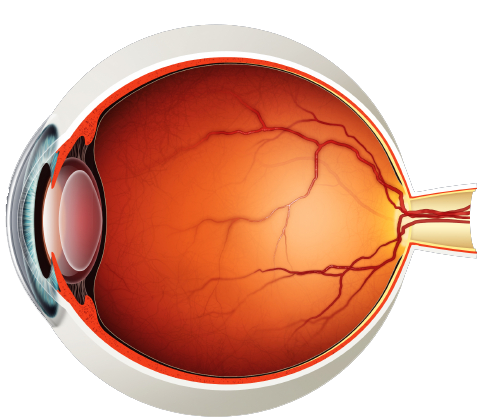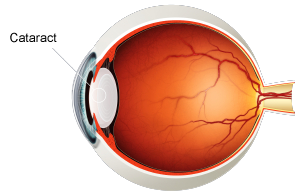Cataracts

What is a cataract?
Cataracts are among the most common age-related eye conditions; it is estimated that over 60% of Americans will develop a cataract at some point during their lifetimes. This condition is characterized by the lens of the eye becoming cloudy, impairing vision to varying degrees. The lens is a clear part of the eye that helps to focus light, or an image, on the retina. In a normal eye, light passes through the transparent lens to the retina. Once it reaches the retina, light is changed into nerve  signals that are sent to the brain.
signals that are sent to the brain.
The lens must be clear for the retina to receive a sharp image. If the lens is cloudy from a cataract, the image you see will be blurred.
Who is at risk for a cataract?
The risk for developing cataracts increases with age, however, the exact triggers for cataracts are not fully understood. It is generally agreed other risk factors include:
- Exposure to ultraviolet light
- Exposure to cigarette smoke
- Certain diseases like diabetes
There are things you can do to protect your vision like wearing sunglasses, live a healthy lifestyle, and if you are 60 and older have a yearly dilated eye exam.

What are the symptoms of a cataract?
Symptoms of a cataract may include:
- Blurred or distorted vision
- Sensitivity to light, especially bright lights from oncoming car headlights
- Need to get closer to see distant objects, such as road signs
- Loss of depth perception
- A change in the color of the pupil to a milky white or yellow

How are cataracts detected?
Cataracts can only be diagnosed by an ophthalmologist during a comprehensive eye examination. During a comprehensive eye exam, the ophthalmologist performs a variety of vision tests including:
- A visual acuity test using the letter eye chart to determine vision at various distances
- A pupil dilation test to examine the eye’s lens and retina
- A tonometry test to measure the fluid pressure within the eye
These tests measure vision loss, night vision, peripheral vision, and sensitivity to glare. The ophthalmologist uses the results of these tests to determine whether you have a cataract.
How are cataracts treated?
Fortunately, cataracts are highly treatable. In the early stages, glasses and contacts will help the problem. As the cataract progresses, however, vision quality will usually decrease to the point where surgery is the best option. Dr. Lavery, in keeping up with the most advanced procedures, is an expert in cataract surgery. This procedure is one of the least invasive cataract surgeries available.
